
ISSN: 2321 9653; IC Value: 45.98; SJ Impact Factor: 7.538

Volume 10 Issue X Oct 2022 Available at www.ijraset.com


ISSN: 2321 9653; IC Value: 45.98; SJ Impact Factor: 7.538

Volume 10 Issue X Oct 2022 Available at www.ijraset.com
Preeta Sharan1 , Chetan V2 ,
1Professor, Department of ECE, The Oxford College Of Engineering, Bengaluru, India
2Student, Department of ECE, The Oxford College Of Engineering, Bengaluru, India
Abstract: Railways has huge network of trains which carries passenger and goods from one place to another. With increase in population, demand of railway transport is increasing day by day. Real challenge comes in continuous monitoring of train parameters such as axle count, weight of wagon, speeds etc. In this work, FEA (finite element analysis) is implemented on the model of rail and wheel using the software known as ANSYS v15.0. Grating MOD is used to carry out the FBG (Fibre Bragg Grating) sensor simulation. The obtained analysis is used to design a Graphical User Interface with a display to calculate the load.
Keywords: Train Speed and Weight; Equivalent Elastic Strain; Optical sensors; Display;
Railways are one of the essential means of transportation in India, where people rely on railway system to travel across different parts of the country. There is a need for improved reliability, efficiency and safety in railways for smooth functioning of trains in every part of the country. To create an intelligent and smart railway network, FBG comes into the picture. It requires huge sensor networks, consisting hundreds of sensor for measuring different parameters such as strain, stress, temperature and vibration given in [1]. Monitoring speed and weight [2] can be done using Gaussian model determined which gives the distribution of the horizontal strain due to the vehicles. Based on pavement mechanical responses, monitoring of the traffic can be done with the estimation of weight and speed. Real time experiments [3] is done at different speed from 60kmph to 200kmph, vertical stress and strain were estimated. Resilient modulus (Mr) can be found these stress and strain where it is concluded that resilient modulus (Mr) decreases by 10% when train speed increases from 100kmph to 200kmph. There are many algorithms that depend on wheel loads and train speeds as given in [4], use time of the peak strain to calculate speed. Shear strain algorithm estimate the wheel speed while axial strain is related to wheel load. Paper [5 6] presents how Fiber Bragg Grating can detect the speed of train. In this work, wheel load 80 tons at three different speeds are considered 60, 70, 80 kmph. The results obtained by the analysis is used to design a Graphical User Interface to calculate the train load connected with a display to represent the load properties, with the scope of converting it into an embedded system.
The working principle of the grating sensors, the parameters required to simulate the sensor in Grating MOD tool, and modelling of the track and wheel contact theory is explained in this section.
The Grating is made on an optical fiber so that it reflects a particular wavelength of light, transmitting everything else in response to create an optical sensor known as FBG (Fiber Bragg Grating) sensor. It consists of small core of 5 to 8 µm diameter and an outer part cladding of 120 µm diameter, made up of pure glass SiO2 [6]. The refractive index of core is higher than the cladding as it is made of Si doped Ge.
Fig. 1
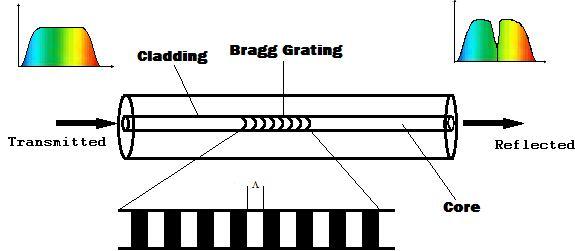
ISSN: 2321 9653; IC Value: 45.98; SJ Impact Factor: 7.538 Volume 10 Issue X Oct 2022 Available at www.ijraset.com

The light would propagate only in the core, since the index of refraction of the cladding and core are different, the light undergoes total internal reflection. The refractive index of the core is changed permanently and gratings as given in (1) are written onto the fiber Bragg’s Reflection principle which is given as, B = 2. Λ (1)
Where, Λ = distance between the grating (period of the grating) = Effective refractive index Bragg resonant wavelength is determined by various factors applied on the FBG, which affect effectively refractive index or grating periodic variation. FBG measures external factors such as strain, temperature, pressure by detecting changes in the reflected Bragg’s wavelength. External parameters affect effective refractive index and grating period, due to which there is a shift in resonant wavelength . This makes FBG a smart sensor and can be used as various types of sensors such as pressure sensor, temperature sensor and strain sensor etc. [8]. Shift in Bragg’s wavelength due to external strain and temperature can be described in (2), ∆ B = (1 Pe) ∆ɛ + (α + ζ) ∆T (2)
Where, Pe is electro optic constant, ∆ɛ is equivalent strain and T is change in temperature, α is thermal expansion coefficient, ζ is thermo optic coefficient. 1.2pm or 13pm are FBG’s sensitivity at 1550nm of wavelength. Fiber Bragg Grating sensors has wide range of applications because of their several advantages [7] over classical sensors like multiplexing capability, high precision, long life time, durability, calibration is not required and also the fiber is immune to EMI (Electromagnetic interference).
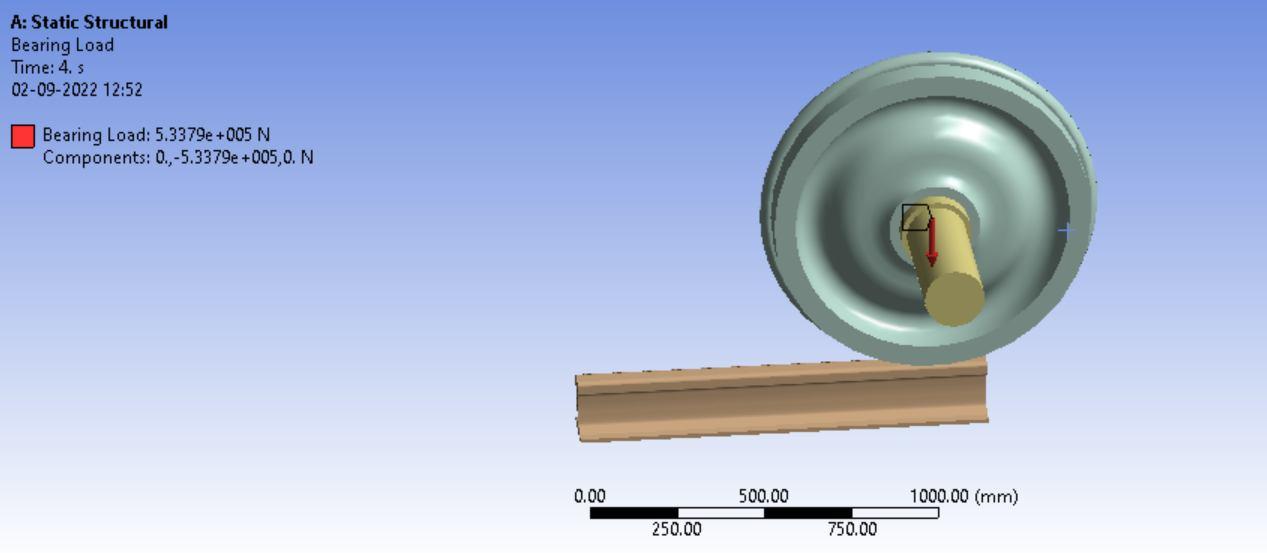
The wheel and rail are made with a material which has high tensile strength such as structural steel. The behavioral difference of the rail and wheel depends on the factor that weather the element of contact is wheel and of target is rail or the other way [9].
The various classes of intersectional joints describe different positional contacts such as fixed, transitional and planar. The contact of ground to rail, axle and wheel is defined by the three types of joints as fixed, transitional and planar joints. The Figure 2 presents Bearing load in y direction on the wheel towards the railway track downwards. According to the static structural analysis of wheel rail model used for FEA analysis, it shows the rotational velocity of 12.15 rad at 4 sec. Different speed are considered from 60 kmph to 80 kmph to calculate equivalent strain and stress. Appropriate nodes are selected along the web region of the rail to detect strain and total deformation on the railway track, as represented in Figure 3.
ISSN: 2321 9653; IC Value: 45.98; SJ Impact Factor: 7.538

Volume 10 Issue X Oct 2022 Available at www.ijraset.com
The meshing of the model is done based on the material properties defined The element of size 50mm is considered for fine meshing, which results in the accurate magnitudes of the rolling surface contact, the area where the rail and wheel are contacting. The interference of the rail track and the wheel is found to be frictional with the frictional coefficient of 0.5. The mesh analysis of rail wheel contact is carried out in the Ansys software. Figure 4 represents the joint displacement taken in x direction along the length of the rail.
The two phases of the result is explained below.
To analyze the behavior of Corresponding Elastic stress and strain with the variation of speed of the train, FEA analysis of Rail Wheel has been done in ANSYS15.0 software. The results from the ANSYS are used to define change in wavelength of optical sensor. The ANSYS software is divided into three parts preprocessor, processor and postprocessor. In preprocessor material characteristics and geometry conditions are defined. In processor, we define boundary conditions, nodes along the rail and parameters that is different speed are applied, evaluate the solution and finally in post processor, results are evaluated, stress and strain is calculated [11]. Cross section area of rail is 76.15 x 10 4 m, 7600 Kg/m3 of rail density. The Table I gives the result of ANSYS solution.
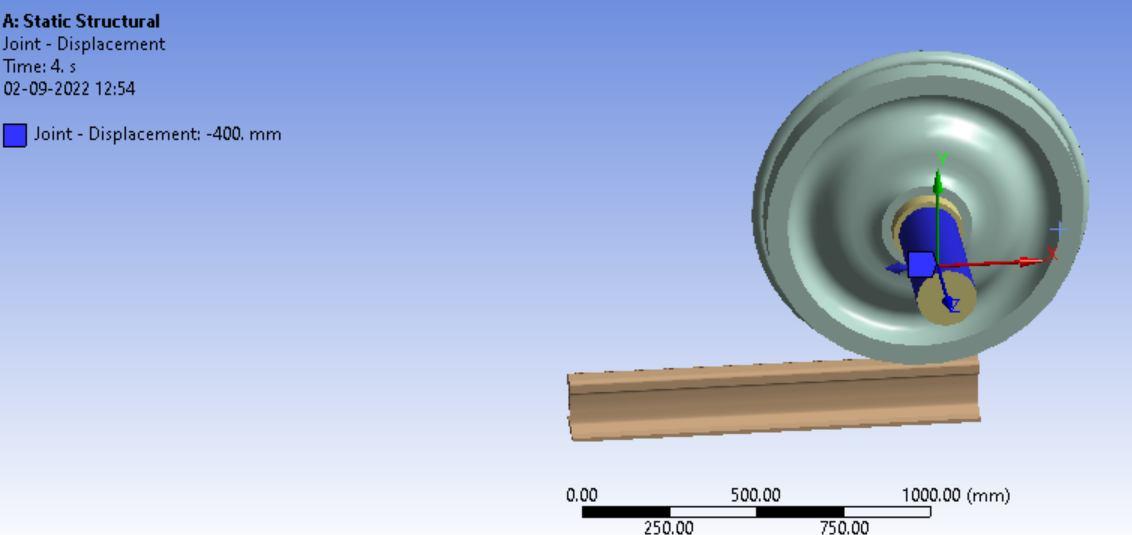
According to the output simulations taken in Figure 5, the center wavelength of the optical sensor is varied from 1551.4801 to 1551.4845nm; the optical sensor is elongated due to the impact of strain. We observe grating spectral response at speed 60kmph strain is that when wavelength is 1551.4801nm, reflectivity is 85.6957%. Then with varying wavelength, reflectivity decreases by 0.0001%. The spectral response at 70kmph where grating pitch is 0.526902 and reflectivity is 85.6956%.
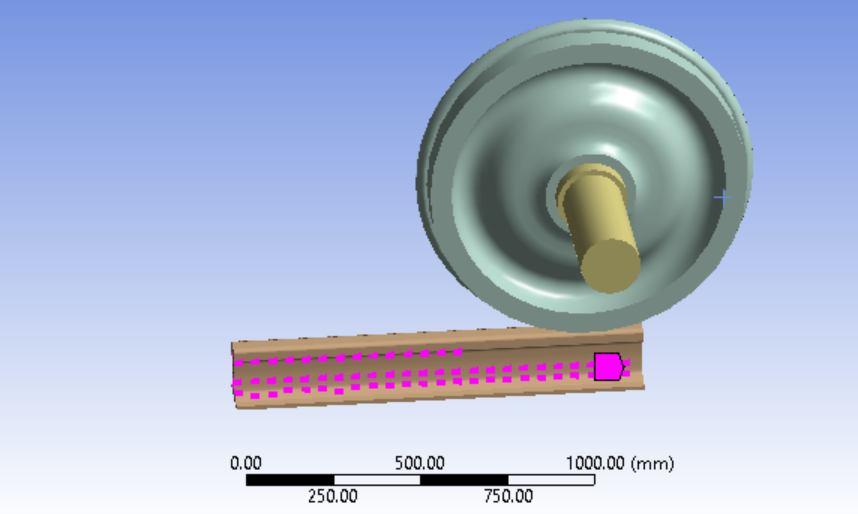
ISSN: 2321 9653; IC Value: 45.98; SJ Impact Factor: 7.538 Volume 10 Issue X Oct 2022 Available at www.ijraset.com

TABLEI
Type of Load 60 kmph 70 kmph 80 kmph
Equivalent Elastic Strain (mm/mm)
Von Mises Stress (MPA)
Max 0.0000517 0.0000521 0.0000567 Min 2.077e 15 1.08e 06 2.111e 15
Max 190.56 190.68 190.96 Min 3.76e 10 3.676e 10 3.728e 10 Node point 237 237 237
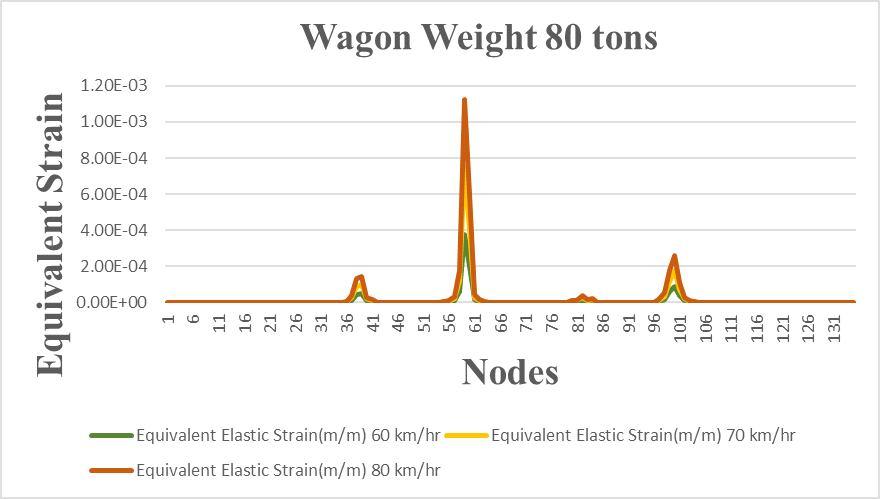
The RI value varies from 3.452348 to 3.452356. From the results we can conclude, that change in Bragg’s wavelength, 1550nm changes the pitch and changed the reflection coefficient given in the figure.
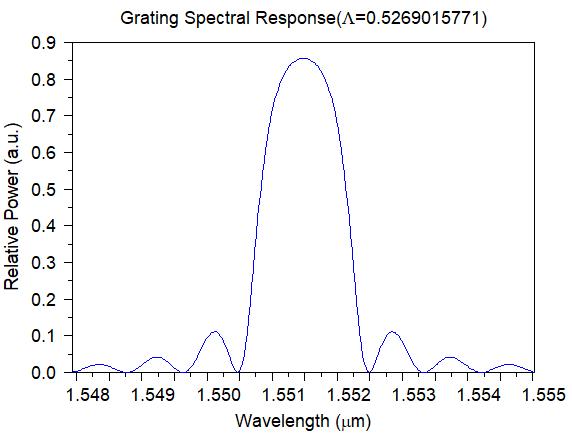
The results give the effectiveness of designing Fiber Bragg Grating sensor in Grating MOD tool. With this, the designed and simulated sensor characteristics were also studied.
In this work, a significant result is observed by analyzing the impact of the 60tons wheel load on the rail which is modeled as a Graphical User Interface with a display and control to calculate the weight of the train and to determine whether it is loaded or unloaded. The analysis includes strain, stress and deformation at the contact region caused by the vertical wheel load [12]. At the speed of 80kmph with 1.40pm/µɛ, the FBG is said to be highly sensitive. This study also includes the behavior of stress and strain with varying speed of the train further relate to study weigh in motion of railways, to observe the behavior of wagon weights with the increasing speed of the train and, comparing with gross train weight and smart structural monitoring.
ISSN: 2321 9653; IC Value: 45.98; SJ Impact Factor: 7.538 Volume 10 Issue X Oct 2022 Available at www.ijraset.com
The change in strain at high speed was observed in this work The obtained experimental results can be used further for the analysis while studying the conditions of the rail and wheel. To identify the wagon with worst wheel condition that is to locate the position where the wheel is flattened. Further the strain signal values can also be passed through the filters such as low pass and high pass to detect the flattened wheel from the change in the frequency of the signal.
Authors would like to acknowledge the faculty of ECE Department and R & D Department, Oxford College of Engineering, Bengaluru for providing lab facility and required software and guidance for completing the work
[1] Radek Martinek, Jan Nedoma, Marcel Fajkus, and Radana Kahankova, May2018, “Fiber optic Bragg Sensors for the rail applications”,International Journal of Mechanical Engineering and Robotics Research Vol. 7, No. 3, pp. 292 295.J. Clerk Maxwell, A Treatise on Electricity and Magnetism, 3rd ed., vol. 2. Oxford: Clarendon, 1892, pp.68 73.
[2] I.S. Jacobs and C.P. Bean, “Fine particles, thin films and exchange anisotropy,” in Magnetism, vol. III, G.T. Rado and H. Suhl, Eds. New York: Academic, 1963, pp. 271 350.
[3] Wenjing Xue, Dong Wang, and Linbing Wang, August 2015, “Monitoring the speed, configurations, and weight of vehicles using an In Situ wireless sensing network”, IEEE transactions on intelligent transportation systems, Vol. 16, No. 4, pp. 1667 167.R. Nicole, “Title of paper with only first word capitalized,” J. Name Stand. Abbrev. in press.
[4] Francisco Lamas Lopez , Yu Jun Cui , Nicolas , Sofia Costa D’Aguiar , Tongwei Zhang, 23 September 2017, “Impact of train speed on the mechanical behaviours of track bed materials”, Journal of Rock Mechanics and Geotechnical Engineering, pp. 819 829.
[5] Thattarath Madathil Deepthi , Umakanthan Saravanan , Anumolu Meher Prasad, 24th September 2018 “Algorithms to determine wheel loads and speed of trains using strains measured on bridge girders”, pp. 1 26.
[6] Georges Kouroussis, Damien Kinet, Véronique Moeyaert, Julien Dupuy & Christophe Caucheteur, 26 April 2016, “Railway structure monitoring solutions using fibre Bragg grating sensors”, International journal of rail transportation, pp. 1 14.
[7] Andrija Milojevic, Miša Tomic Nenad T. Pavlovic, , October 4 5, 2012, “Application of FBG sensors in smart railways”, XV International Scientific Expert Conference on Railways.
[8] C. C. Lai, Jacob C. P. Kam, David C. C. Leung, Tony K. Y. Lee, Aiken Y. M. Tam, S. L. Ho, H. Y. Tam, and Michael S. Y. Liu,” Development of a fiber optic sensing system for train vibration and train weight measurements in Hong Kong”, Hindawi Publishing Corporation, Journal of Sensors, Volume 2012, Article ID 365165, doi:10.1155/2012/365165, pp. 1 7.
[9] Carlo Edoardo Campanella, Antonello Cuccovillo, Clarissa Campanella, Abdulkadir Yurt and Vittorio M. N. Passaro, 15 September 2018, “Fibre Bragg Grating based strain sensors: Review of technology and applications”, pp. 1 27.
[10] R. Kasanna, K. Ajay, M. K. Naidu, S. Adinarayana, I. Sudhakar, July 2017, “Design and analysis of Indian wheel rail assembly for super elevation”, International Journal for Research in Applied Science & Engineering Technology, Vol 5 , Issue VII.
[11] Reem Sharma, Rajesh Rohilla, Mohit Sharma, Dr. T.C.Manjunath, “Design & simulation of optical fiber bragg grating pressure sensor for minimum attenuation criteria”, Journal of Theoretical and Applied Information Technology, pp. 515 530.
[12] B. Jagadeep, P. Kiran Kumar, K. Venkata Subbaiah, May 2018,“Stress analysis on rail wheel contact”, International Journal of Research in Engineering, Science and Management, Vol 1, Issue 5, pp. 47 52.

